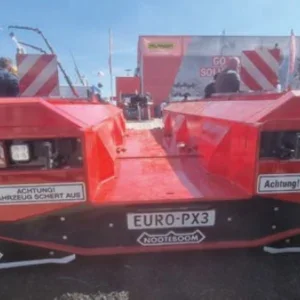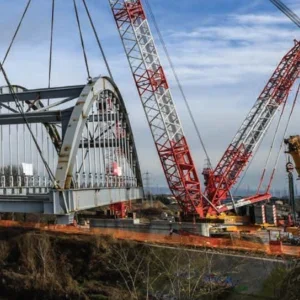Penny Hydraulics, founded in Derbyshire in 1978 by John Penny, Sr., started out servicing hydraulic equipment for the mining industry. Mining was still a major part of the local economy at the time, and products for mining are still an important part of the business today. Now, Penny Hydraulics has grown to manufacture hydraulic lifting equipment and bespoke handling solutions.
Providing services to the garage equipment industry prompted the design of its first crane, about a year into the business, and that part of the company grew rapidly.
Penny Hydraulics introduced its Swing Lift range of vehicle-mounted cranes to meet the specific demands from end users for a lightweight and compact unit that could be installed on smaller vehicles. Customers include telecoms provider BT, which installs a small crane on the majority of its service engineering vehicles, and railways engineers Network Rail.
The company’s range now includes models with maximum loads from 100kg to 2,000kg and it still focuses on the small to medium size vehicle market. Recently, to meet market demand, the company introduced fully-hydraulic, vehicle-mounted 500kg and 1000kg models with fullhydraulic lift, extension and slew.
E Rand & Sons Ltd has installed two of the smallest Penny cranes on its vehicles. A general engineering company providing diesel, electrical, mechanical and fluid engineering services, Rand works with a variety of organisations from hospital NHS trusts, to food processors and bus depots.
“We were looking for two small cranes to fit in the back of Ford Transit vans to lift Allison automatic transmission units,” says Jon Clarke, sales director of Rand. “They weigh about 180kg, and we were looking for a compact, powerful lift to do away with other ways of getting them in and out.”
Prior to buying the cranes, engineers would use a forklift truck to lift the transmissions into the vans at Rand’s workshop. Once on site, not everyone would have similar equipment to take the unit out of the van, explains Clarke. “If they haven’t got a forklift truck, you had to get four people to manhandle it out of the truck and it’s obviously way, way too heavy for people to do that.
“So it was to overcome the problem of manual handing if there was no mechanical lifting system on the sites. “I just asked one of my engineers who has one fitted to his van what he thought about it, and he said he’s got so used to using it now, he couldn’t do without it.”
One of Clarke’s engineers had seen the equipment and mentioned it to him. Penny sent out a demonstration van with three different set-ups. “I had half a dozen of my fitters out there to look at it. And we were able to see what best suited our application,” he says.
Any new vans required for that specific part of Rand’s business will be fit with another unit, Clarke says. “The fact that the arm actually folds is very useful. You still leave space in the van itself. The lifting gear doesn’t take up a huge amount of space.”
Many of the company’s products start as custom designs for a particular end user or application and are then introduced to the broader market—such as the Grid Lift, developed a few years ago in collaboration with Atkins engineering and design consultancy.
Simon White, contract director of highway services for Atkins, oversees the company’s contract with Somerset County Council, where about 170 staff members, 100 of which are frontline roadworkers, do everything from filling potholes and gritting the roads to highway improvement and bridge strengthening schemes. Part of the job is maintenance and cleaning of the county council’s highway drainage network, which includes emptying all 133,000 gullies (the iron grates on the roadside drains) of silt and dirt on the Somerset network.
Each gully has a chamber under the road, typically anywhere between 50cm–1m deep. Six crews empty the gullies on a cyclical basis using specific gully emptying maintenance vehicles. “They do about 100 gullies a day, so they’ll go down the road, and on a typical road you’ve got a gully every 10m,” explains White.
“The common industry practice is, each crew has got a metal hook, which they put around, underneath the grating, and they sort of yank it about and pull the ironwork out over 100 times day—with pure manpower. That’s how they’ve traditionally done it.”
The grids weigh between 20kg and 100kg and he estimates each crew lifts about 100 pieces, which would be about one tonne of ironwork, a day. And a lot of the grates get jammed down as they’re constantly overrun by lorries and cars, or dirt can get rammed in, locking them into position and causing a lot of strain. “And it’s not just the weight; it’s repetitive. They’re doing exactly the same motion, day in and day out, 100 gullies a day, 500 a week,” says White.
While the gully cleaning crews only account for 10% of Atkins’ workforce in Somerset, injuries to this section made up 25% of the total accidents—until one of Atikins’ lead operators suffered a severe back injury during one of the jobs. Once back at work, he began to sketch and develop ideas for a mechanical lifting solution. Atkins then contacted Penny Hydraulics, who created a prototype and the two companies worked together to produce the Grid Lift, an extending hydraulic arm, mounted to a gully emptier vehicle that drops down to attach to a cover and lift it clear of the drain.
The Grid Lift is now fitted to all gully emptier vehicles at Atkins and, says White, a number of its competitors are taking them on as well as other councils who do this work in-house. Atkins is also looking at developing a similar solution with Penny for lifting manhole covers. White says, from purely a cost point of view, the company is saving thousands of pounds a year avoiding lost time from accidents.
“We were working in terms of what was the industry standard of just lifting these with a gully hook,” he says. “However Atkins, particularly highway services, is really focused on making all of our operations increasingly safe.” From the first year of its contract with Somerset (2003), it has cut accidents from about 45 accidents, seven of which were more serious, to 14 accidents, two of which were serious, in 2010.
In June, it was announced that Penny Hydraulic and Atkins have won the 2010 Health and Safety at Work award from The Chartered Institution of Highways and Transportation for their work together developing the Grid Lift.
Penny has also developed other nonvehicle crane solutions for customers, including a crane for installing glass panes on the roof of the British Museum, cranes installed on all terrain vehicles for the Ministry of Defence, cranes for handling nuclear waste at power stations and portable davit cranes for use by water companies to retrieve underground pumps at remote sites.






